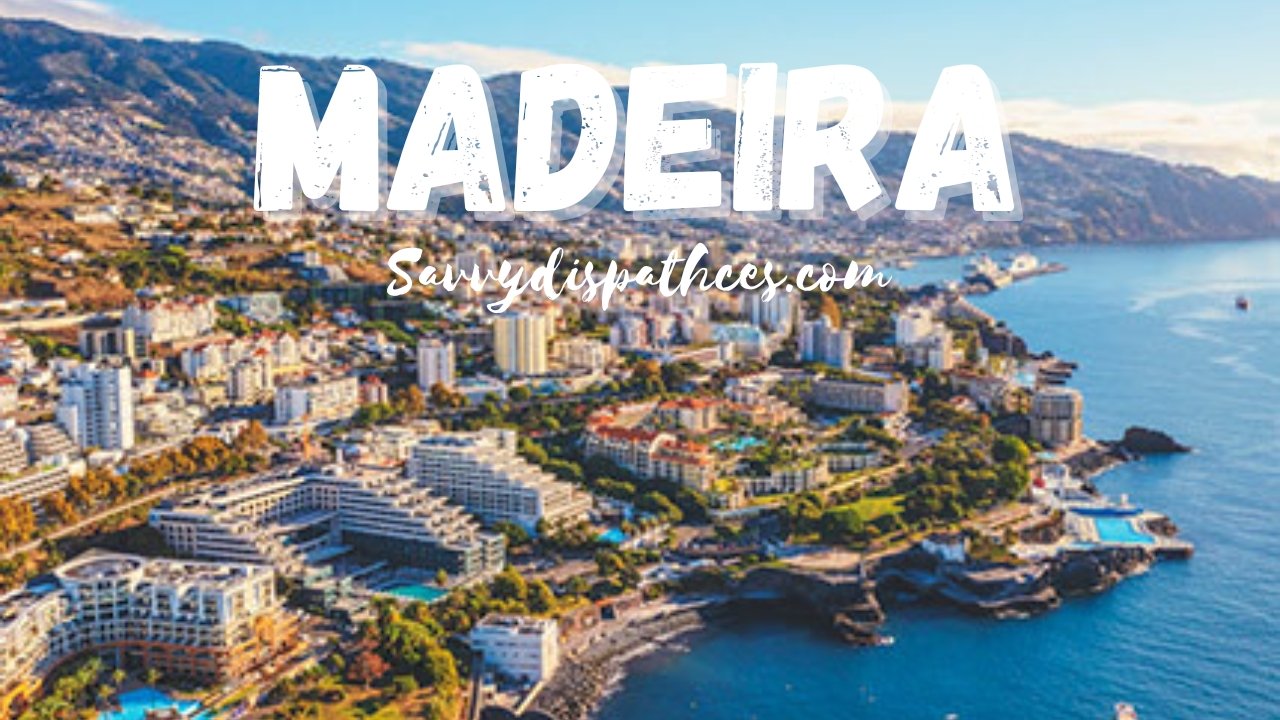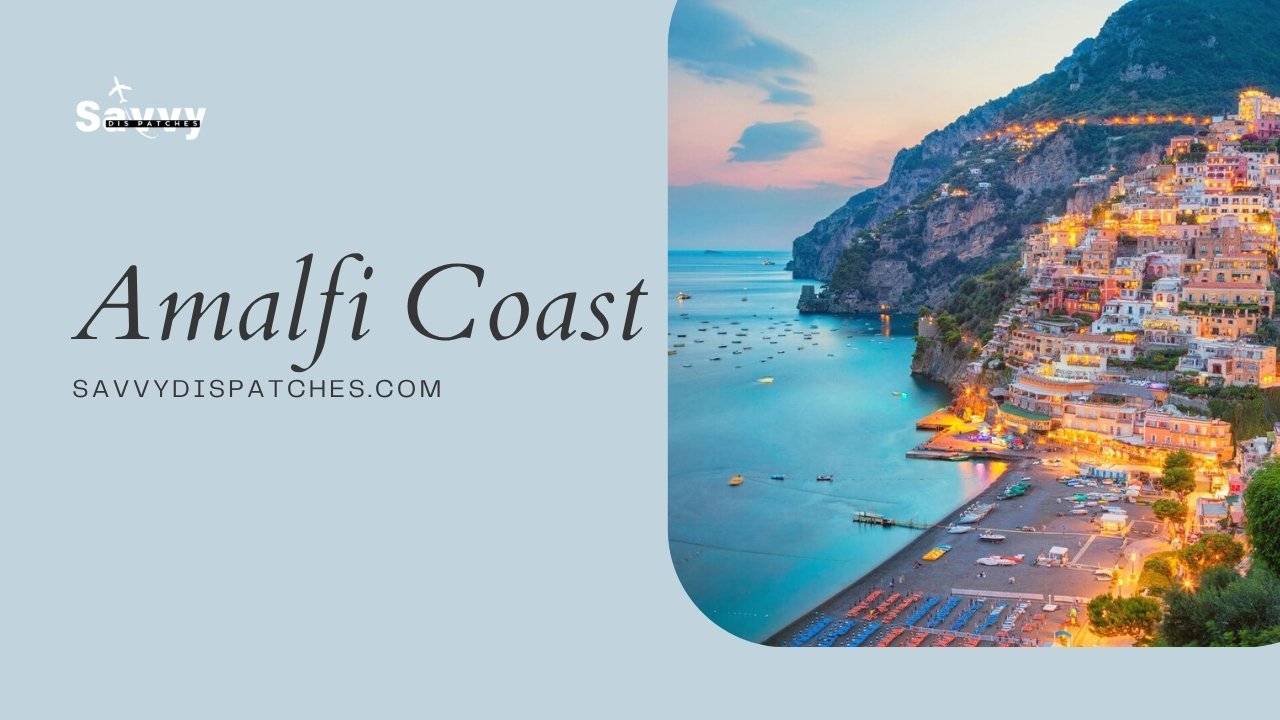Travel
Perhentian Islands: How to Get There, What to Expect, & More

Located on the northeast coast of peninsular Malaysia is a pair of islands known as the Perhentians. The name Perhentian translates roughly to “stopping place,” as it was a frequent stop for Malay traders heading north to Bangkok. The two islands are straightforwardly dubbed Perhentian Kecil and Perhentian Besar – meaning Little Perhentian and Big Perhentian respectively. In mid-March, Emmett and I decided to head to these islands ourselves to see what the fuss was about. You see, we’d heard that the coral reefs were stunning and that we were pretty much guaranteed to see a sea turtle. We tried not to get our hopes up too high, though it turned out we had nothing to worry about. All the rumors were true and we were ultimately blown away by the natural beauty of the two Perhentians.
Visiting the Perhentian Islands
Before our trip, I found that a good amount of the information available online about traveling to the Perhentians was either outdated, incomplete, or both. Thus, while I was there, I soaked up as much info as possible to be able to provide the guide I wish I’d had. Fair warning: this will be a longer post, so I have broken it up into a table of contents. Feel free to skip ahead to whatever information applies to you & your potential Perhentian questions.
1. Packing for the Perhentians
2. How to Get There
3. Where to Stay
4. Where to Snorkel
5. More Things to Do
1.
What to Pack
Beyond your standard clothes or other items you normally have with you, be sure to bring the following beach essentials:
+ Sunscreen
+ Sunglasses
+ Swimsuit
+ Snorkel & Mask & Fins
+ Mosquito/bug repellant
+ Hat
+ Quick-dry Towel
+ Dry Bag or other Waterproof Bag
+ Waterproof Camera – if you’ve got one
Beyond those essentials, I highly recommend that you also bring at least one book or playing cards or some other item with which to entertain yourself. WiFi is spotty at best and most often non-existent. Also, if your accommodation is of the budget variety (as ours was), you will probably want a mosquito net. The mosquitoes are everywhere (even in March!) and budget cabins don’t have mosquito nets. Make sure your camera, other devices, and any spare batteries are all charged up before you go. Most budget accommodation runs on generators and will often not even have an outlet for charging. If you’re a budget traveler who likes to cook their own food and avoid eating out: bring food with you. There are a few general stores selling things like ramen but at highly inflated prices. Even just a handful of granola bars can save you from having to eat every meal of the day out at the cafes.
Lastly: there are no ATMS available, so be sure to bring plenty of cash. Resorts and larger establishments will take cards but really: cash is king.
How to Get to the Perhentians
From Kuala Lumpur:
There is one bus a day, managed by Bus NKS, leaving Kuala Lumpur Sentral with a connection in Jerantut bound for Kuala Besut (port city for Perhentians). The journey will take at least 9 hours.
Other transportation possibilities from KL include a rental car, train to bus transfers, or short domestic flights.
From Penang/Langkawi:
You can take a bus from Butterworth (port city for Penang & Langkawi) to Kuala Besut (port city for Perhentians). Be warned though, since you’re going to the literal opposite side of the country, the bumpy bus ride will take 8 or 9 hours. We did this ride overnight when leaving the Perhentians to get to Penang.
From Cameron Highlands/Taman Negara:
Take a private shuttle. This is something I would recommend that you book a few days ahead of time at your accommodation in Taman Negara or the Cameron Highlands. That’s what we did – our hostel in the Highlands put us on a shuttle bus called “Golden Highlands.” The price of the ticket for the two of us was 250 MYR ($65 USD) and included not only the 6 hour shuttle ride but also the cost of the ferry transfer to Perhentian Kecil.
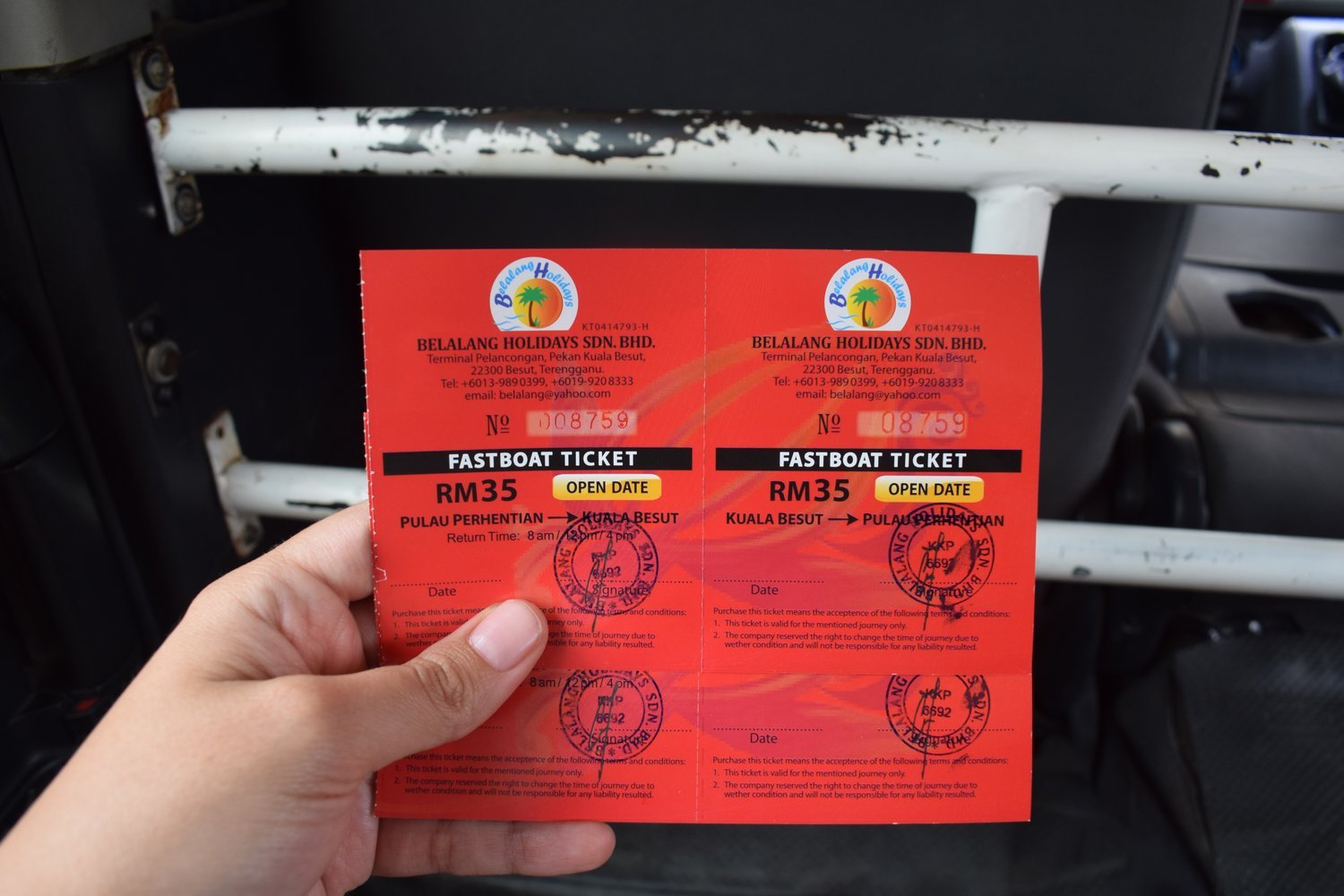
Ferrying to the islands from Kuala Besut:
As of our visit in March 2018, you needed to not only have paid for your ferry ticket (approx 35 MYR or $8 USD per person for open return tickets) BUT also pay a fee to enter the Pulau Redang Marine National Park. This fee was 30 MYR per person (about $7.50) at the docks prior to boarding and supposedly goes towards conservation initiatives on and around the islands.
A quick note about the fastboat “ferries” taking you to the Perhentian islands:
Make sure all of your stuff is secured in your bag and anything valuable is in a dry bag or plastic bag. The speedboats are so fast over the surprisingly choppy seas. Loads of spray will come in the boat onto you and your bag. Not to mention that the boat catches so much air that a) your butt will hurt from slamming into the seats and b) two backpacks nearly flew out into the ocean when our boat jumped a particularly huge wave. Luckily, those of us sitting in the front were alert and grabbed them by the straps just as they launched. The pack owners were very grateful. I’d hope someone would do the same for me but you never know – better to prepare for the worst.
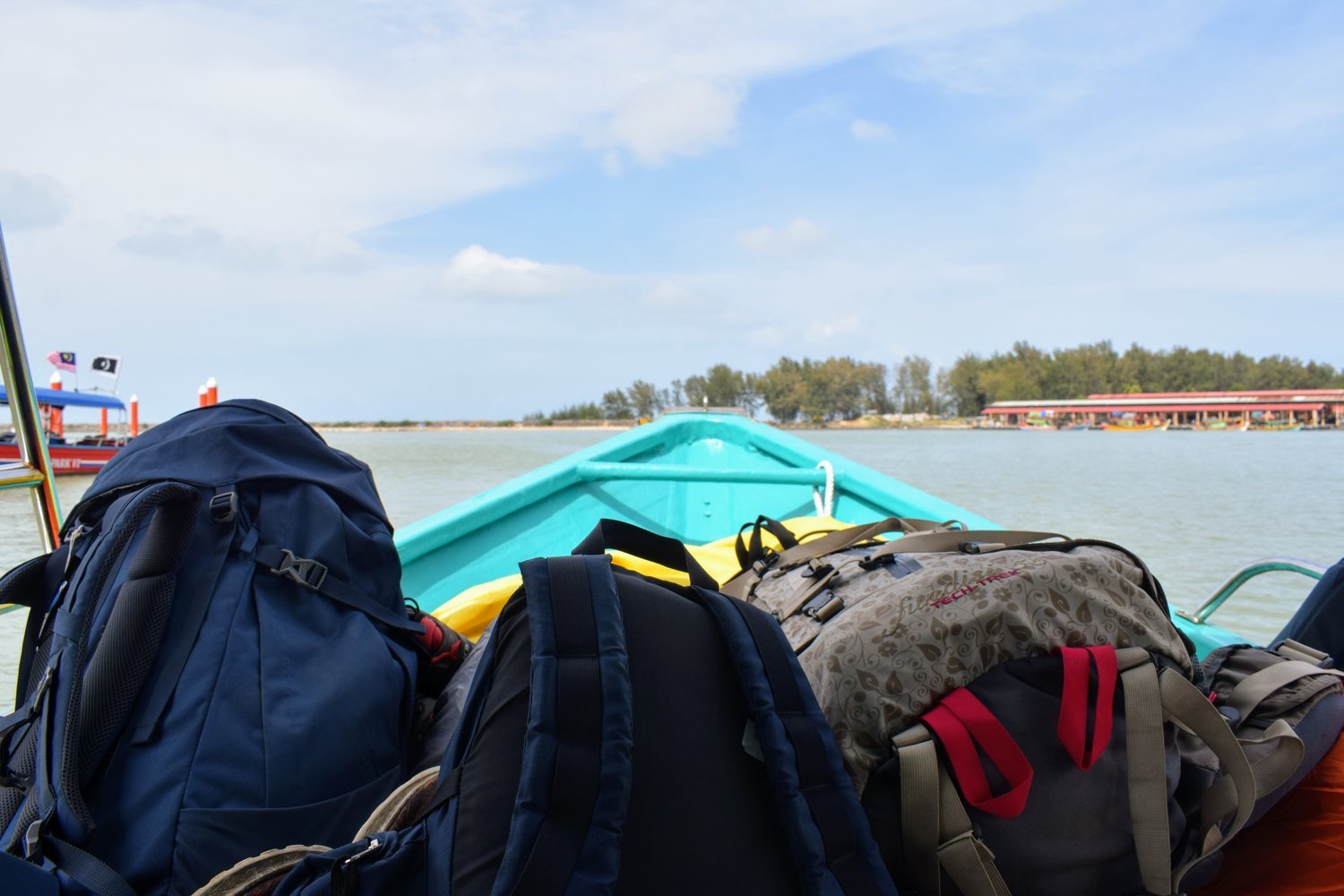
Moments before some of these bags nearly flew off into the water.
3.
Finding Accommodation
Budget
If you’re on a budget, your best bet is to just show up. Preferably mid-week before the weekend travelers arrive. Perhentian Kecil is the more backpacker-friendly island, so going there will be your best bet if you’re looking to save. Once you get off the fastboat, walk along Coral Bay or Long Beach and pop in a few locations to check availability and compare prices. Some of the places have dorms, others have private rooms with a fan, basically it’s worth an ask wherever you go. Try anywhere with the name “Chalet” (such as Fatimah Chalet, Amelia Chalet, Butterfly Chalet, etc.) for a cheaper option.
Quick side note: To get to Long Beach on Perhentian Kecil, get off the ferry at Coral Bay. There is a walkway that starts at Ombak Dive Resort and takes you fifteen minutes through the jungle in the center of the island. There are quite a few chalets along this path and even more once the path opens up onto the wide mouth of Long Beach.
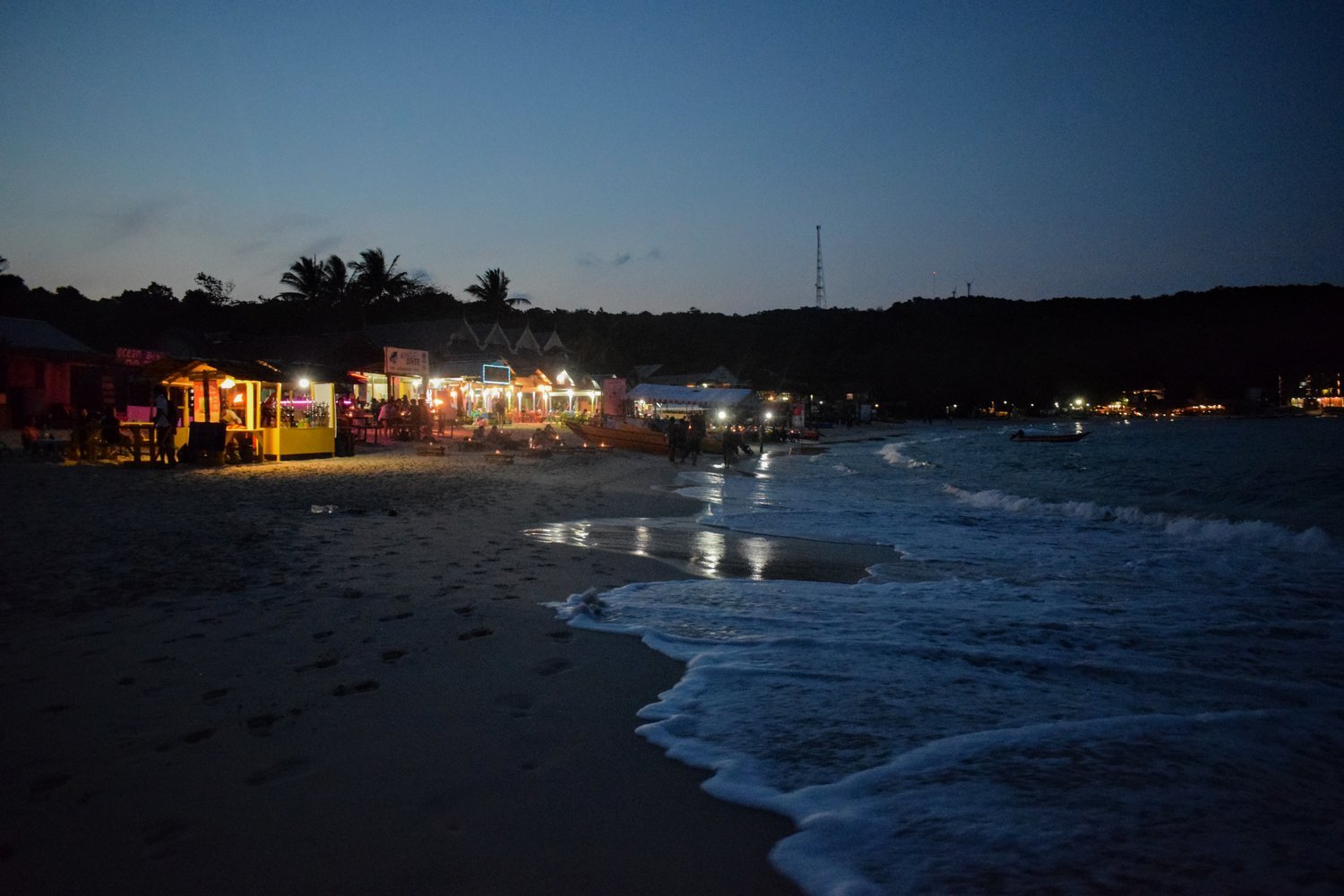
Long Beach on Perhentian Kecil, just before the beach parties began.
Mid-Range to Luxury
After a few budget nights in a buggy chalet, we spent one night at Ombak Dive Resort ($50 USD or 150 MYR a night for a twin room) on Perhentian Kecil. Ombak had very clean, comfortable western-style rooms with en suite bathrooms and a very tasty breakfast buffet. Another Kecil resort option would be Shari-La Resort, which has it’s own private beach and is located just off of the main dock at Coral Bay.
For more luxury options, go to Perhentian Besar instead. The accommodation – and the general atmosphere – there is less backpacker-oriented and more like the kind of place someone might honeymoon. Places like Tuna Bay Island Resort or Flora Bay Resort may be the perfect place to have a quiet and luxurious stay.
Accommodation For Divers
The Perhentians are known for their marine life and thus there are numerous dive resorts sprinkled across each island. Some resorts also offer a package for divers to stay and take a course. On Perhentian Kecil, the resort with the best reputation is Ombak Dive Resort. As I mentioned above, we spent a night there and the facilities were lovely. On Perhentian Besar, Bubbles Dive Resort has the best reputation for dive & accommodation packages.
4.
Snorkeling in the Perhentians
I really, really would like to become SCUBA certified some day – as would Emmett. However, the price wasn’t right for us in the Perhentians, so we opted to snorkel instead and had a FANTASTIC time. There are quite a few options for snorkeling around the Perhentians which I will outline below.
Snorkeling at Coral Bay
Whether you have your own snorkeling gear or you rent some from one of the many snorkel tour stands at Coral Bay, you’ll be delighted to find that you don’t need to hire a boat to see some beautiful underwater scenery. There are two places that are good for snorkeling just off of Coral Bay. The first one can be reached by getting in the water just off of the left of the dock when facing Shari-La Resort. The area is roped off with buoys for safe swimming away from boat traffic. The coral wasn’t too great there but there were quite a few anemones being guarded by cutely defensive clownfish. The second snorkeling spot is a bit further off and also buoy-roped off. Starting in front of Butterfly Chalet, swim towards the left over the shallow sand until the coast curves into a slight cove. Just around the bend, you will find lots of healthy purple coral (see above) as well as giant clams, parrot fish, and other tropical swimmers. Be forewarned: if the tide is going out, the currents can be a bit on the swifter side in this area.
If you’re on Long Beach, I do not recommend attempting to swim at all there – let alone snorkel. There is a lot of surf and the currents are strong. A friend of ours was nearly carried into some rocks and we watched another person get rescued after being swept out too far. Most tellingly, on the first day we visited, one of the cafes on Long Beach posted a sign near the waterfront that honestly said “No Swimming!! Danger!! Death!!”
Boat-Based Snorkel Tours
full day snorkel tour around the islands. There are many little shed-based snorkel tour companies lining Coral Bay. We chose the one in front of Amelia’s Cafe & Chalet. I don’t believe that it was any better than the rest of the choices available on the beachfront. Honestly, each boat will take you to the same 6 locations (4 if it’s a half day) for about the same price. The full day tour will take you to massive coral heads with tons of colorful fish, bait a black-tipped reef shark over towards your group, scout out green sea turtles grazing on algae for you to swim near, take you to dock-based cafés at Fisherman’s Village, drop you next to a small reef lighthouse, and end your tour on a gorgeous white sand beach called “Romantik Beach.” If you’ve got the time for a 6 hour tour… GO! It was about 50 MYR ($15 USD) per person.
That being said, if you have more than just a few days: take more than just one boat tour. Emmett and I were seriously considering chartering a boat out to Redang Island just to see if there was even better coral further out. I’m sure there is. There are other snorkeling spots in the Marine Park besides Redang as well – I’ll bet that there are so many wonders of the sea just waiting to be seen.
An Important Note About Snorkel Tours & Conservation
Emmett and I were disappointed to find that there was little education or discussion about reef health before or during our snorkel boat tour. We saw people from our own tour and others standing or sitting on live coral. Do not touch the coral or any other marine life. Touching the coral and especially STANDING on it will kill the coral. Coral reefs are already struggling to survive due to climate change, so don’t quicken the process by handling any marine life. Also, I heard a guide tell one of his clients that they could grab onto a sea turtle. Please do not touch sea turtles. Do not grab sea turtles. Swim a polite distance away from the turtles. They are wild animals who do not need the stress of being grabbed by a human.
Honestly, I recommend that you bring up these important points if you see fellow snorkelers misbehaving. In most cases, I think people genuinely don’t know they’re acting harmfully.
5.
Beyond Snorkeling/Diving: Things to Do in the Perhentian Islands
1. Stroll the beach while looking at seashells and other beach treasures. ..Always one of my favorite relaxing beach activities!
2. Get a fresh fruit smoothie from one of the many cafés on a hot afternoon. Our favorites were at Daneila’s on Long Beach.
3. Watch an evening movie at Ombak Resort’s outdoor theater/restaurant on Kecil.
4. Go to Long Beach after dark for one of the many beach parties/bonfires held by local bars.
5. Walk Kecil or Besar’s jungle trails.
6. Keep an eye out for the resident water monitor lizards who proudly creep all over these islands.
7. Try the “best roti canai” from the stand outside of Fatimah’s at Coral Bay – you won’t be disappointed.
8. Buy a cheap beach read from Ewan Café’s stash of used books.
9. Relax after a long day of snorkeling by getting a massage at one of the many affordable massage parlors/mini spas on the islands.
10. Bliss out in the sunshine – just be sure to wear sunscreen.
There you have it: a guide to the Perhentian Islands. I hope that I covered any questions you might have. Let me know your thoughts in the comment section below!
Destinations
Madeira Travel Guide: Top Attractions, Hidden Gems & Local Tips
Destinations
Amalfi Coast Travel Guide: A Journey for Every Type of Traveler
Travel
How to Choose the Best Fat Tire Electric Bike for Different Terrains

How to Choose the Best Fat Tire Electric Bike for Different Terrains
Choosing the best fat tire electric bike for your terrain isn’t just about looks—it’s about performance and comfort. The right e-bike depends on where you ride: smooth pavement, rocky trails, sandy beaches, or snowy roads. Each surface demands specific tires, suspension, and motor power.
This guide will walk you through how to pick the perfect fat tire e-bike for every type of terrain.
What Makes Fat Tire Electric Bikes Unique?
Fat tire electric bikes stand out because of their oversized tires—usually 4” to 5” wide—that offer better traction and stability. Whether it’s a moped-style electric bike for city cruising or a rugged off-road model, these bikes handle diverse terrains with ease.
Key Advantages:
- Excellent grip on loose or slippery surfaces
- Smoother ride on uneven terrain
- Better balance for new riders
- Support for heavier loads or cargo setups
Most fat tire e-bikes feature 500W to 1000W motors and ≥80 Nm torque, making them ideal for both hills and flat roads.
1. Best Fat Tire Electric Bike for City Streets
If you’re riding mostly on asphalt, paved trails, or urban bike lanes, comfort and efficiency matter most.
What to Look For:
- Tire Type: Semi-slick or hybrid tread (4.0”) for low rolling resistance.
- Motor Power: 500–750W hub motor for smooth acceleration.
- Battery Range: At least 48V 15Ah (40–50 miles per charge).
- Suspension: Front fork only—light and efficient for city use.
- Frame Style: Step-thru or moped-style electric bike for easy mounting.
Example setup:
A 750W fat tire commuter e-bike with 20″x4″ semi-slick tires offers great traction without draining power on smooth roads.
Pro Tip: Inflate your tires to 20–25 PSI for better efficiency and speed on pavement.
2. Best Fat Tire Electric Bike for Mountain Trails
Mountain terrain demands more power, stronger frames, and better suspension.
What to Look For:
- Motor: 750W–1000W mid-drive motor with ≥80 Nm torque for hill climbing.
- Suspension: Full suspension (front + rear) to absorb shocks.
- Tires: Deep tread 4.8” tires for traction on gravel and mud.
- Brakes: Hydraulic disc brakes (180mm rotors) for steep descents.
- Battery: 48V 20Ah or dual-battery setup for long trail rides.
- Ideal PSI: 12–18 PSI for rocky trails.
Pro Tip: A mid-drive motor keeps your center of gravity low and improves handling on tight, winding paths.
3. Best Fat Tire Electric Bike for Snowy Conditions
Snow requires traction and stability—this is where fat tire e-bikes truly shine.
What to Look For:
- Motor: 750–1000W rear hub motor (torque ≥85 Nm).
- Tires: 4.8” studded or knobby tires for maximum grip.
- Frame Material: Aluminum alloy to prevent rust.
- Battery: High-capacity 48V 17–20Ah (cold weather drains battery faster).
- Fenders: Full coverage to block slush and debris.
Pro Tip: Keep your battery warm indoors before riding—it maintains up to 15% more charge efficiency in winter.
4. Best Fat Tire Electric Bike for Beach or Sand Riding
Soft sand is tricky. You’ll need wide tires, a strong motor, and corrosion resistance.
What to Look For:
- Tires: Ultra-wide 4.5–5.0” tires with low PSI (8–12 PSI).
- Motor: 750W or 1000W rear hub motor for consistent power.
- Battery: 48V 15Ah minimum—sand adds resistance.
- Frame Coating: Anti-rust treatment or aluminum alloy frame.
- Drivetrain: Sealed components to protect from sand and salt.
Pro Tip: After beach rides, rinse your e-bike with fresh water and dry it thoroughly to avoid corrosion.
Comparison Table: Fat Tire E-Bike Terrain Guide
| Terrain Type | Ideal Tire Width | Motor Power | Suspension | Battery | Recommended PSI |
| City Streets | 4.0″ semi-slick | 500–750W | Front | 48V 15Ah | 20–25 PSI |
| Mountain Trails | 4.8″ knobby | 750–1000W | Full | 48V 20Ah+ | 12–18 PSI |
| Snow | 4.8″ studded | 750–1000W | Front | 48V 17Ah+ | 10–15 PSI |
| Beach/Sand | 4.5–5.0″ | 750–1000W | Front | 48V 15Ah+ | 8–12 PSI |
Extra Features Worth Considering
- Pedal Assist Levels: Choose models with at least 5 PAS modes for flexibility.
- Display: An LCD with real-time speed, range, and PAS data helps monitor performance.
- Lighting: Integrated LED lights improve safety for night rides.
- Accessories: Racks, baskets, or child seats can make your ride more functional.
Tips for Beginners vs. Advanced Riders
For Beginners:
- Start with a step-thru frame for easy handling.
- Use pedal assist mode to extend battery life.
- Keep tires at higher PSI for smoother roads.
For Advanced Riders:
- Go for dual batteries if you ride long distances.
- Experiment with lower PSI on dirt or snow for more grip.
- Upgrade to hydraulic brakes for precision control.
Conclusion
The best fat tire electric bike depends on where you ride most. City commuters should look for semi-slick tires and moderate power, while mountain and beach riders need wider tires, stronger motors, and solid suspension. By matching your bike’s setup to your terrain, you’ll enjoy smoother rides, longer range, and better control.

 Blog10 months ago
Blog10 months agoHow to Deal with Scabies While Traveling

 Travel10 months ago
Travel10 months agoRichmond, Virginia Street Art Guide

 Travel10 months ago
Travel10 months agoHow to Live in Your Car in New Zealand

 Travel10 months ago
Travel10 months agoSouvenir in Nepal: A Guide to Unique Handicrafts and Cultural Treasures

 Travel10 months ago
Travel10 months agoVegan Guide to Dining Out in Richmond, Virginia

 Food10 months ago
Food10 months agoVegetarian Food Nepal: A Journey into Flavorful Plant-Based Cuisine

 Travel7 months ago
Travel7 months agoA Local’s Guide to Sanibel Island, Florida

 Travel7 months ago
Travel7 months agoVisiting Lumbini, the Birthplace of the Buddha

